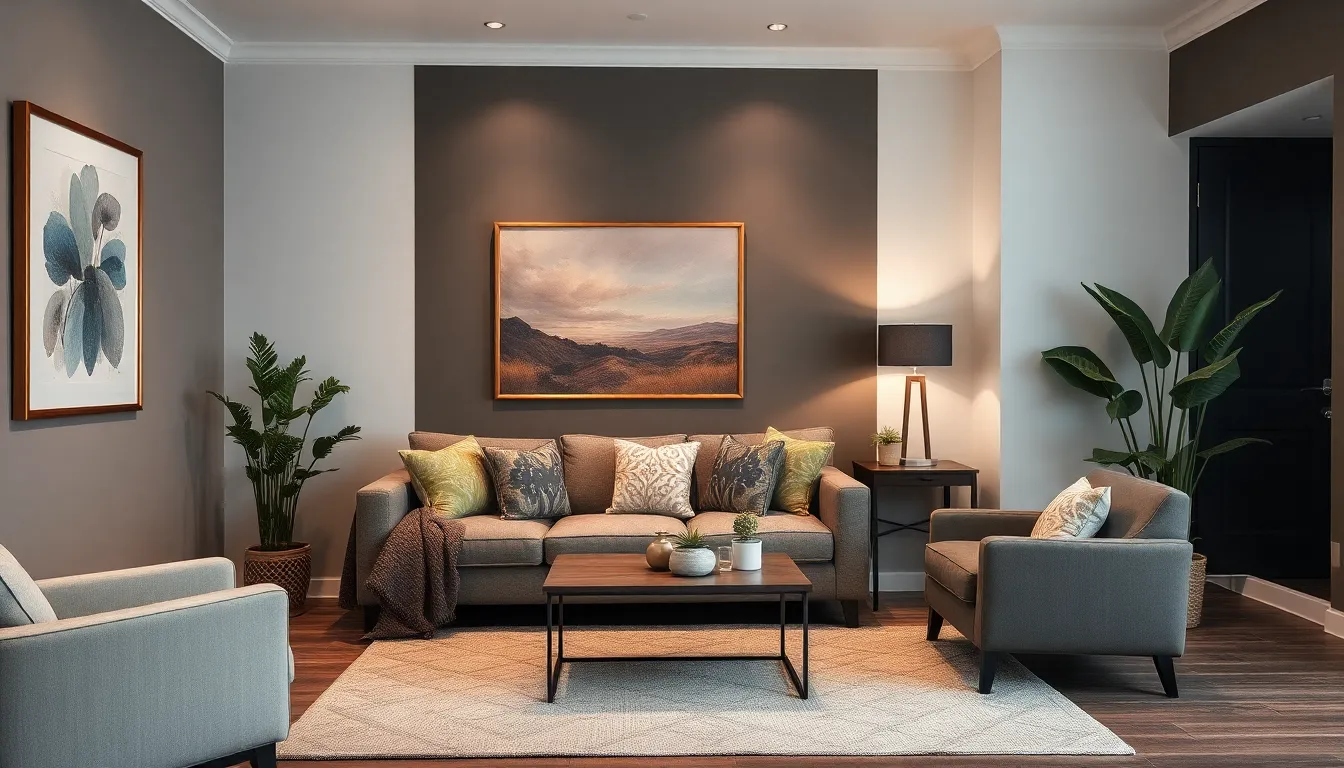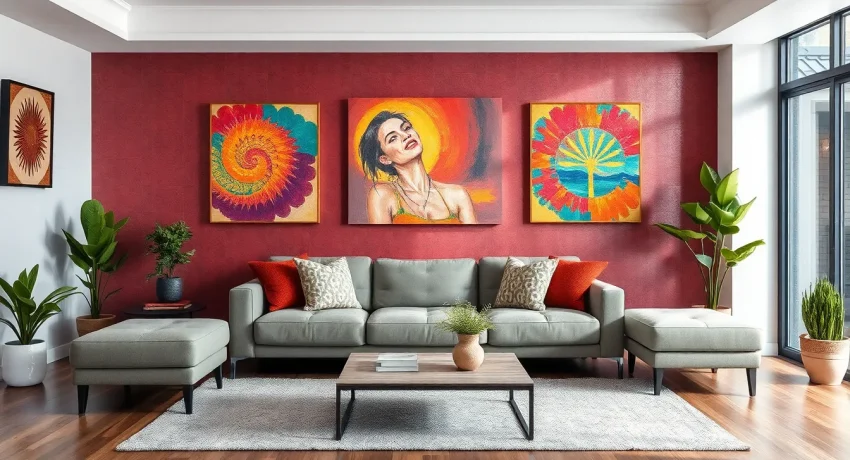When it comes to decorating a room, the age-old question arises: how many walls should really get the royal treatment? It’s like trying to decide how many slices of pizza to order—too few, and you’ll be left craving more; too many, and you’ll feel stuffed and regretful. Striking the right balance is key to creating a space that’s both stylish and inviting.
Table of Contents
ToggleThe Importance of Wall Decoration
Wall decoration significantly impacts a room’s overall atmosphere. Art, colors, and textures contribute to creating a specific mood. A well-decorated wall draws attention and can serve as a focal point in the space. Surroundings often feel more inviting with the right decoration choices.
Choosing to decorate specific walls can enhance harmony in a room. By focusing on two or three walls, individuals can prevent clutter while maintaining visual interest. This approach results in balancing empty spaces and decorated areas, resulting in a more appealing environment.
Walls can express personal style and create a unique identity for the room. Featuring artwork or photographs can allow for creativity and self-expression. Such decor evokes emotions, making the space more relatable and comfortable.
Additionally, colors play a vital role in wall decoration. Light colors can make a room feel airy and spacious, while dark colors create intimacy and warmth. Choosing colors that complement furniture and decor can unify the room’s appearance.
Strategically decorating different wall areas can enhance a room’s functionality. Accent walls can establish zones within an open space, helping delineate purpose without physical barriers. Functional areas benefit from thoughtful wall decorations that support activity while adding style.
Ultimately, wall decoration serves practical and aesthetic purposes, enhancing both form and function. Thoughtful design decisions cater to personal taste while transforming a basic room into a stylish sanctuary.
Factors to Consider for Wall Decoration

Considering wall decoration involves multiple aspects. Evaluating room size and layout offers insights on which walls to emphasize.
Room Size and Layout
A small room typically benefits from lighter shades and minimal decor on one or two walls. Opting for strategic decoration in such spaces creates an illusion of openness. Larger rooms often allow for more extensive decoration across three or four walls, enhancing depth. Utilizing the layout helps define zones, such as separating dining and living areas. The arrangement of furniture also influences wall decoration decisions; focal points such as televisions or artwork guide placement.
Purpose of the Room
Understanding a room’s purpose shapes wall decoration choices. In a bedroom, calming colors and personal artwork create a restful atmosphere. For a home office, motivational quotes may inspire productivity. High-traffic areas, like living rooms, often feature durable and easy-to-clean materials. In contrast, dining rooms can showcase decorative elements that enhance social interaction. Each purpose dictates different styles and colors, ensuring harmony with the overall design.
Popular Trends in Wall Decoration
Wall decoration trends evolve, influencing how spaces feel and function. Selecting the right approach impacts the ambiance and aesthetic of a room.
Accent Walls
Accent walls add a striking focal point to a room. Choosing one wall encourages creativity with bold colors, patterns, or textures. These walls create visual interest without overwhelming the space. A green wall may evoke tranquility in a bedroom, while a vibrant blue adds energy to a home office. Typically, homeowners use these features to highlight art pieces or unique furniture arrangements. Accent walls also serve as conversation starters, providing a point of engagement for guests.
Full Room Decor
Full room decor embraces a cohesive design across all walls. This approach creates a unified atmosphere, enhancing the overall aesthetic. Rich, harmonious color schemes help establish mood and character. Using complementary shades makes rooms feel larger and brighter. Designers often incorporate various textures, such as wallpaper and fabric, for depth. Lush botanical prints or sophisticated geometric patterns can enhance personal style. Ultimately, full room decor supports a thematic consistency, making spaces feel more intentional and complete.
Balancing Aesthetics and Functionality
Finding harmony between aesthetics and functionality is essential when decorating walls. Art and color choices influence the room’s atmosphere significantly. Design goals guide wall decoration decisions, ensuring spaces are both inviting and practical.
Smaller spaces benefit from lighter colors and less decoration, which creates an open feel. In contrast, larger rooms offer flexibility for extensive decoration while maintaining visual balance. Defining zones within larger areas often improves flow and usability.
Strategic decoration enhances room functionality through effective zoning. For instance, using a bolder color or pattern on a wall can delineate the dining area from the living space. Artwork can serve dual purposes, conveying personal style while enhancing the mood of a room.
Room usage drives decisions about decoration style. Bedrooms often favor calming hues, while home offices benefit from motivational artwork. High-traffic areas may require durable materials that withstand wear, ensuring long-lasting beauty.
Various trends in wall decoration impact both ambiance and functionality. Accent walls function as focal points, offering bold designs that attract attention without overwhelming. Cohesive design across all walls fosters thematic consistency, contributing to a unified look.
Personal expression is vital in decorating walls. Individuals can showcase creativity through art and photographs while still adhering to functional needs. Achieving a balanced approach transforms any space into a stylish and practical environment.
Personal Style and Preferences
Individuals play a significant role in determining how many walls to decorate in a room. Personal style influences decisions on artwork, colors, and textures. Some prefer minimalism with just one or two walls adorned, creating a serene environment. Others lean toward more vibrant designs, letting creativity shine through by decorating all available walls.
Art pieces and photographs become expressions of personality, showcasing interests and experiences. Individual tastes may favor bright colors that energize spaces or neutral tones that foster tranquility. A well-curated selection not only enhances aesthetic appeal but also aligns with the room’s purpose.
Mood can shift based on the choice of decoration. For instance, calming colors often suit bedrooms while motivational quotes may thrive in home offices. This tailored approach to wall decoration facilitates a connection between the environment and the activities performed within it.
Personal preferences manifest in the selection and arrangement of elements. Choosing a cohesive theme or contrasting styles invites opportunities for visual intrigue. Factors like layout and natural light also contribute to the final look, helping to harmonize the chosen decorations with the overall space.
Harmonizing decor with functional needs plays a critical role. High-traffic areas may require durable artwork, prioritizing both style and practicality. Ultimately, integrating personal style into wall decoration transforms spaces, making them reflective of individual tastes while maintaining a balanced, inviting atmosphere.
Finding the right number of walls to decorate can transform a room into a stylish haven. By focusing on two or three walls, individuals can strike a balance between aesthetics and functionality. This approach not only enhances the visual appeal but also allows for personal expression through art and color choices.
The impact of wall decoration extends beyond mere appearance; it influences the overall atmosphere and mood of the space. Thoughtful decoration can create zones and enhance the room’s purpose, making it more inviting and enjoyable. Ultimately, embracing personal style while maintaining harmony in design will lead to a beautifully curated environment that reflects individual tastes.




